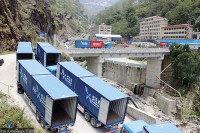Money
‘Potential of Nepali herbal products still untapped’
Nepali herbal products have immense potential to secure notable exports earnings but the lack of research, absence of proper processing and failing to label appropriate specifications have been impeding its business prospects, experts have said.
Nepali herbal products have immense potential to secure notable exports earnings but the lack of research, absence of proper processing and failing to label appropriate specifications have been impeding its business prospects, experts have said.
Professor Dhaka Ram Bhandari from Justus Liebig University, Germany, said Nepal has huge resources of chemical biodiversity that is mainly found in plant resources. Giving instances of chiuri butter (Diploknema butyracea), Bhandari said that a large quantity of the unprocessed product is now being exported to Germany and Italy.
“As more and more people in developed countries become attracted to herbal medicines and cosmetics extracted from the naturally found chemical composition, Nepal should focus on exporting such processed herbal products,” said Bhandari speaking at a session of recently concluded First NRN Global Knowledge Convention 2018.
Usually, the herbs found at an altitude of 3,000 metres and above are considered rich in natural chemicals. “The country is losing a huge amount of potential revenue every year in absence of a mechanism for labelling and providing specifications,” said Bhandari adding that the turmeric found in Nepal could also secure good market in Europe if attention is given to packaging and marketing.
According to the Current Macroeconomic Report of Nepal Rastra Bank, the country exported herbal products worth Rs1.02 billion in 2017-18, almost 36 percent more than the figure in the previous year. In that herbal export figure, export to third countries almost doubled to Rs295.9 million while the rest of the earnings were from India. Turmeric, pepper (timmur), asparagus (kurilo), cinnamon, spikenard (jatamasi) among others are the country’s main exportable herbs. Most of the herbs from Nepal are exported to Indian medicine factories, departmental stores and resold in other
countries.
Nepal Trade Integration Strategy (NTIS) 2016 has recognised medicinal herbs as an important product having huge export potential. According to a study report prepared by GIZ—a German Development Agency—few years ago, the market for natural and organic personal care and cosmetics products in the European Union is estimated to cross 2 billion euro.
Bhandari said that a lack of awareness and initiatives at the local level was also hindering the business of Nepali herbal products abroad, despite having huge potential. He also stressed on the need of utilising the community forests for herbal production. “Though the concept of community forests has come up with a good outcome in preserving plant diversity, however they are limited to just producing timber and animal fodder.”
Praising the growing number of Nepali pharmaceutical companies, Bhandari also urged the companies to focus on developing molecules from locally available plants rather than imported chemicals. Professor Tara Sigdel from University of California, San Francisco, sought the need to develop a conglomerate in order to fully utilise untapped resources. According to him, a diaspora of Nepali experts have been doing well in the field of biomedicine abroad. “Amid the expanding scope of biomedicine in the international market, Nepal should invite the country’s experts in the domestic network to carry out more research in the sector that will economically benefit the country,” Sigdel said.




 20.12°C Kathmandu
20.12°C Kathmandu














